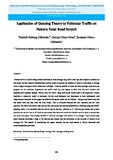| dc.contributor.author | Odhiambo, Fredrick Ochieng | |
| dc.contributor.author | Orwa, George Otieno | |
| dc.contributor.author | Otieno, Romanus Odhiambo | |
| dc.date.accessioned | 2018-11-23T15:48:28Z | |
| dc.date.accessioned | 2020-02-05T16:36:08Z | |
| dc.date.available | 2018-11-23T15:48:28Z | |
| dc.date.available | 2020-02-05T16:36:08Z | |
| dc.date.issued | 2017 | |
| dc.identifier.citation | Odhiambo, F. O., Orwa, G. O., & Odhiambo, R. O. (2017). Application of Queuing Theory to Vehicular Traffic on Nakuru Total Road Stretch. American Scientific Research Journal for Engineering, Technology, and Sciences (ASRJETS), 30(1), 295-309. | en_US |
| dc.identifier.uri | http://repository.must.ac.ke/handle/123456789/451 | |
| dc.description.abstract | Nations strive to avoid losing revenue and human lives through long traffic snarl ups and frequent accidents on the roads. For this reason Considerations must be made to increase the number of lanes or even better to change from a single carriage to more robust dual carriages. However number of lanes and dual carriage alone serve no purpose for the accidents frequencies and traffic snarl ups that appear to defy even the most modern and sophisticated highway designs. Service time for traffic using such roads would need to be improved. Clearly therefore a numerical model is necessary for the road designers and developers to help understand road improvement demands. In this paper we establish the queue model for the Nakuru – Salgaa road Stretch and test the model with real data from the Case Study. Data is collected between the Soil- junction and the Total junction. We derive the arrival rate, service rate, utilization rate and the probability of Bulking using the M/M/1 queuing model. It is estimated that the arrival rate at the Soil- junction is 37 vehicles per minute and at total junction the service rate is 44 Vehicles per minute this does not march the dwindle service rates in section that are now black spots. The average number of vehicles on single road stretch is on average 15 per minute with some sections recording a high of 40 vehicles per minute and the utilization of the sections of stretch is on average 0.8. The benefit of performing the queue analysis for the road stretch is finally discussed and recommendations provided. | en_US |
| dc.language.iso | en | en_US |
| dc.publisher | American Scientific Research Journal for Engineering, Technology, and Sciences | en_US |
| dc.subject | Road Section; Queue; Single carriage; dual carriage; waiting times | en_US |
| dc.title | Application of Queuing Theory to Vehicular Traffic on Nakuru Total Road Stretch | en_US |
| dc.type | Article | en_US |

